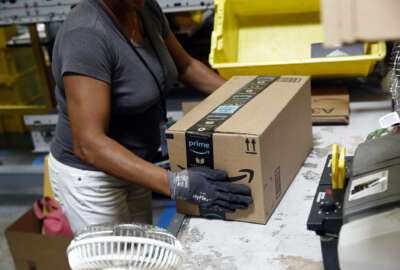

Industry associations’ concerns grow about e-commerce portal with language in the 2019 Defense Authorization bill.
The House Armed Services Committee isn’t sitting idle while the General Services Administration comes up with an implementation strategy for the e-commerce portal, otherwise known as the “Amazon amendment,” over the next nine months.
Once again, lawmakers are trying to disrupt the federal procurement system before the paint is even picked, let alone dry, on the e-commerce portal. The committee approved a provision in the fiscal 2019 Defense Authorization bill that would raise the micro-purchase threshold to $25,000 from $10,000 for all purchases through the forthcoming e-commerce portal.
“The committee expects the commercial e-commerce portals would simplify and streamline the defense acquisition process as well as provide better transparency,” the bill that passed the committee on May 10 states.
GSA also recommended increasing the micro-purchase threshold to $25,000 in its initial implementation plan sent to Congress in March.
Additionally, the bill includes language that would increase the micro-purchase threshold for all other buying approaches across DoD to $10,000 from $5,000. In the 2018 version of the NDAA, all non-DoD agencies received the MPT increase from $3,500 to $10,000.
This latest action by the House committee likely will add to the growing anxiety about the e-commerce portal.
“Everyone who saw that report on first sight was a little taken aback as it was a little unexpected in the defense authorization bill,” said Angela Styles, a former administrator in the Office of Federal Procurement Policy and now a partner with the law firm Bracewell in Washington, D.C., on the Off the Shelf program. “We have no idea of the ramifications will be with the increase. What worries me is the lack of transparency. We as taxpayers will have no idea of what’s going on and to raise the micro-purchase threshold to $25,000 is a huge increase. I think the real question is why increase it to $25,000 before we know what $10,000 looks like?”
Styles wasn’t alone in her concerns about the increase of the MPT.
Jonathan Etherton, a former DoD and congressional executive and now founder of Etherton and Associates, a consultancy for federal contractors, said he too was surprised and thought the rationale by the committee “wasn’t compelling.”
Jonathan Aronie, a partner with the law firm Sheppard Mullin, said there are costs and advantages to raising the micro-purchase threshold, including opening up the government to more produces from overseas, including China. He said the increase would reduce accountability and competition, which would have a dramatic effect on agency and vendors alike.
The concerns about Chinese products, including supply chain risks (see my other notebook item) are so strong that the National Association of Wholesaler-Distributors wrote to President Donald Trump on April 20 expressing serious reservations about the increase of the MPT to $25,000.
“The proposal confounds Executive Order 13788, Buy American and Hire American (April 18, 2017). Instead of fostering the purchase of U.S. goods and products by government agencies, it circumvents and dilutes your Executive Order’s commitment,” writes NAW, which represents approximately 30,000 enterprises of all sizes that employ more than 5.9 million workers in the U.S. “By more than doubling the micro-purchase ceiling, it will expand enormously the foreign products purchased by the government. Its breadth collapses the compliance structure mandated by the Buy American Act and your Executive Order.”
Additionally, NAW writes that GSA hasn’t conducted a cost-benefit analysis and doesn’t seem to be considering one.
“Section 846 fundamentally restructures the way the federal government acquires commercial products. NAW agrees with what we understand to be Section 846’s purpose: to improve the commercial product acquisition process,” the letter states. “We have conveyed to the Congress and to GSA that only meaningful competition at platform and supplier levels will afford fair opportunities to participate and give federal agencies broad choices at competitive pricing. GSA’s jettisoning Buy American Act obligations is wrong. Moreover, the momentum implementing Section. 846 is toward the ‘Amazon Amendment’ model and is to the detriment of countless private sector stakeholders, the federal government and taxpayers. It will generate potentially several billions of dollars annually in fees to what will at best be an extremely limited number of commercial e-commerce portal providers. The disparate, specialized and unique requirements of many federal agencies will be compromised.”
The association requested to the president and Congress that GSA removes its suggestion to increase the MPT and reconsider its overall plan.
Jim Anderson, NAW’s vice president for government relations, told Federal News Radio that the association hasn’t heard back from the White House and continues to educate lawmakers about their concerns.
At the same time, the National Office Products Alliance (NOPA) and the Office Furniture Dealers Alliance (OFDA) are holding a “fly-in” on Monday and Tuesday to meet with lawmakers.
NOPA and other organizations, such as the Institute for Local Self-Reliance, are worried about the e-commerce portal as part of Amazon’s growing influence.
“An important aspect of Amazon’s lobbying strategy will no doubt be how it is a friend to U.S. small businesses rather than a competitor and that using the Amazon Marketplace for federal government purchases will be beneficial to small and medium businesses,” wrote NOPA in a release after Amazon released its Small Business Impact Report in May. “Indeed, that was part of Amazon’s message back in January when the GSA asked for stakeholder input into the proposed federal e-commerce portal. Amazon identified four areas for the GSA to consider: ‘using commercial terms and conditions and commercial practices; enabling robust competition; enhancing opportunities for small and disadvantaged businesses; and encouraging the availability of tools to simplify compliance.’ As U.S. business products associations NOPA and OFDA prepare for their small business advocacy fly-in to Washington later this month, they will be mindful of Amazon’s efforts to portray itself as a platform that underpins small business growth and job creation.”
In its report, Amazon states more than 1 million small and medium sized businesses sell through Amazon, including more than 300,000 who started in 2017, and those firms account for an estimated 900,000 new jobs.
Styles and other experts agreed that GSA needs to do more homework and research to really understand the impact of many of its proposals, including increasing the micro-purchase threshold.
“They have to go out and talk to disinterested companies,” Styles said. “You can have an industry day, but all of those who attended have an interest, so GSA needs to talk to companies out there and learn how they are buying. I think legislative proposals are premature. It’s unusual to have access to GSA thinking and I think they may have some second thoughts after doing more research.”
Etherton added the House provisions to increase the micro-purchase threshold also seem a bit premature given GSA isn’t expected to implement the portal until 2020.
All the more reason why some vendors are so concerned about the House’s effort to put the cart well before the horse.
Copyright © 2025 Federal News Network. All rights reserved. This website is not intended for users located within the European Economic Area.
Jason Miller is executive editor of Federal News Network and directs news coverage on the people, policy and programs of the federal government.
Follow @jmillerWFED


